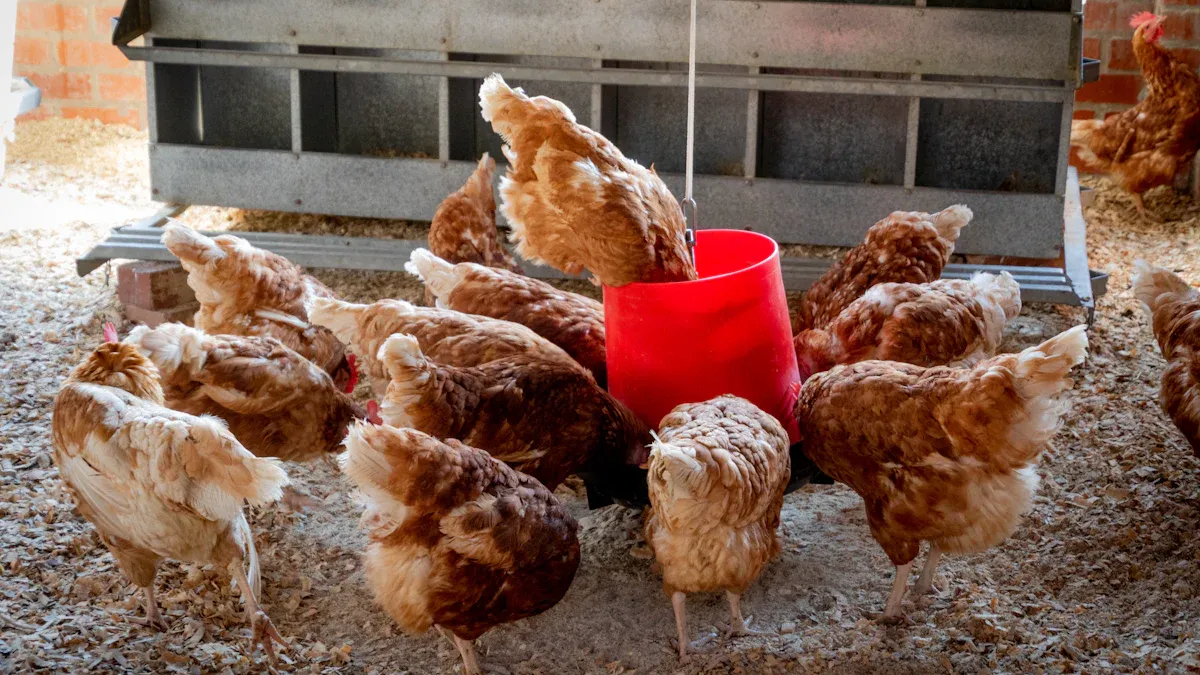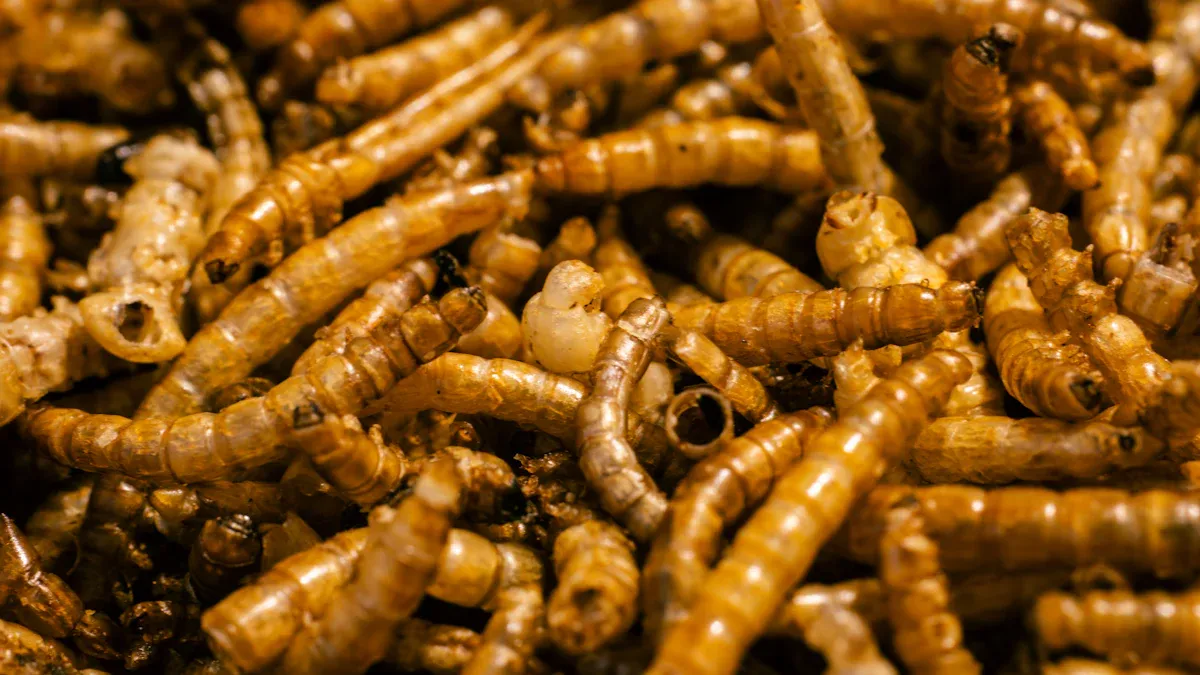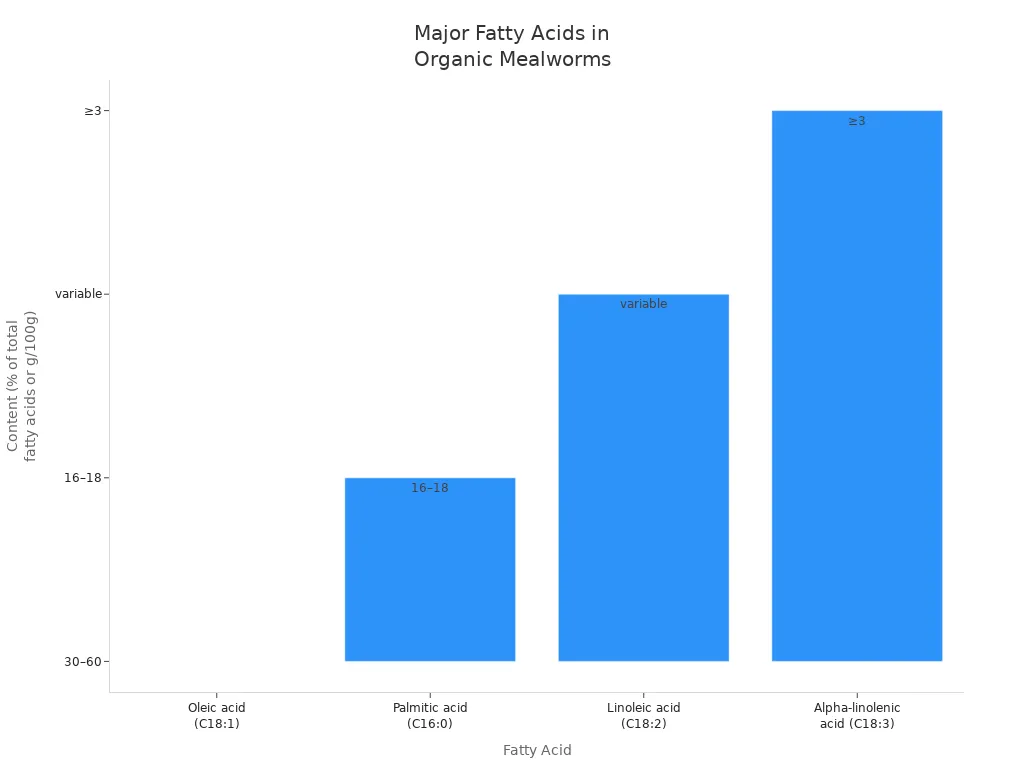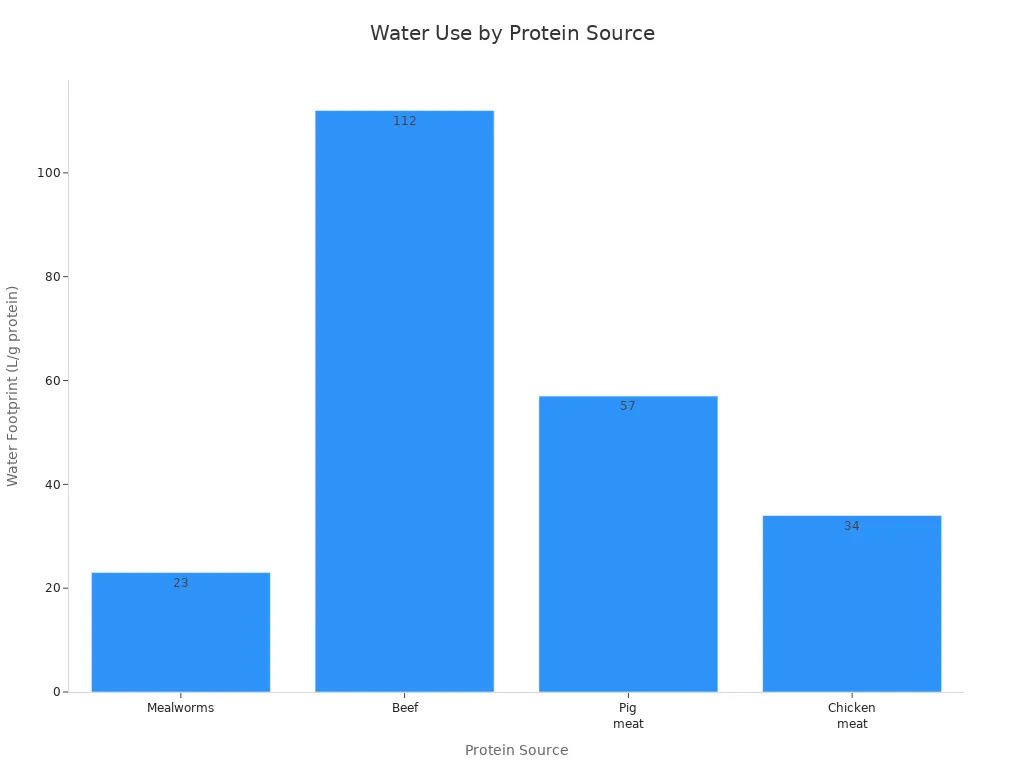
Chickens love a tasty treat, and organic mealworms for chickens serve up serious nutrition. These tiny wrigglers pack more protein and healthy fats than many traditional feeds. Check out the table below to see how mealworms boost body weight gain and feed efficiency compared to soybean meal:
| Parameter | Mealworm Inclusion Effect | Comparison to Soybean Meal |
|---|---|---|
| Body Weight Gain (BWG) | Increased from 1322.0 g to 1423.3 g | Improved over control |
| Feed Conversion Ratio (FCR) | Improved from 1.88 to 1.75 | Better than SBM |
| Immune Response | Improved disease resistance | Enhanced |
Key Takeaways
- Organic mealworms provide chickens with high-quality protein and healthy fats that improve growth, egg quality, and immune health.
- Mealworm farming uses far less water and land than traditional livestock, making it a sustainable and eco-friendly protein source for poultry feed.
- Farmers can easily add dried mealworms to chicken diets as a convenient supplement, but should balance inclusion levels to keep birds healthy and happy.
Organic Mealworms for Chickens: Are They a Viable Alternative?
Practical Benefits and Limitations
Farmers across Europe and beyond have started to notice some exciting changes after adding organic mealworms for chickens to their flocks’ diets. Chickens strut around with shinier feathers and brighter eyes. They peck with more energy and seem happier overall. Many farmers report these practical benefits:
- Chickens show healthier, fuller feathers and more active behavior.
- Egg production increases, with eggs boasting stronger shells and richer yolks.
- Flocks gain weight faster and bounce back from illness more quickly.
- Mealworms fit perfectly into organic and sustainable farming practices.
- The supplements are easy to mix into regular feed and don’t disrupt daily routines.
German organic farmers, in particular, rave about the transformation in their hens. The birds lay more eggs, and the eggs themselves pack more nutrition. Chickens also seem to enjoy the taste, which encourages natural foraging and reduces stress. Farmers love that mealworms are eco-friendly and simple to use, whether dried or live.
Tip: Dried mealworms offer a convenient way to store protein-rich treats for your flock. They last longer and are easy to sprinkle into feed, making them a favorite for busy farmers.
Mealworms bring a high-quality protein punch, but they also deliver essential fats and nutrients. Chickens digest them easily, which means more nutrients get absorbed. This leads to better growth, stronger immunity, and happier birds.
Some challenges exist in the world of poultry feed. Creating a perfectly balanced organic diet can be tricky. Organic rules ban synthetic amino acids, so farmers must rely on natural sources. The protein and fat content in mealworms can vary, depending on what the insects eat. Farmers sometimes need to adjust other parts of the diet to make sure chickens get everything they need. Regulations in some countries also limit what mealworms can eat, which affects how sustainable the process can be. Production costs for insect meal remain higher than for traditional feeds, but many believe the benefits outweigh the price.
| Challenge Type | Description |
|---|---|
| Nutritional Balance | Balancing organic diets is tough without synthetic amino acids. Mealworm nutrients can vary, and some amino acids may be low. |
| Regulatory Limits | Laws restrict what mealworms can eat and require strict tracking. |
| Economic Factors | Producing insect meal costs more than traditional protein sources. |
| Production Challenges | Mealworms need warm environments, which can complicate large-scale farming. |
Direct Comparison to Conventional Protein Sources
Chickens need protein to grow strong and lay plenty of eggs. Traditionally, farmers have relied on soybean meal and fishmeal. Now, organic mealworms for chickens are stepping up as a new contender. How do they stack up?
Scientific studies show that organic mealworms contain between 44 and 69 grams of protein per 100 grams. This matches or even beats the protein content found in soybean meal and fishmeal. Chickens fed with mealworms grow faster and convert feed into body weight more efficiently. Their eggs often have brighter yolks and stronger shells. The birds also show better immunity, thanks to special proteins in mealworms that boost gut health.
Mealworms offer another big advantage: digestibility. Chickens absorb nutrients from mealworms more easily than from many plant-based feeds. This means less waste and more nutrition in every bite. Farmers find that mealworms can replace part of the soybean meal in feed without any drop in performance. In fact, many see improvements in growth, egg quality, and overall health.
Note: Mealworms support natural chicken behaviors, like scratching and pecking, which keeps birds active and reduces stress.
Challenges in Poultry Feed Protein Sources
Limitations of Soybean Meal and Fishmeal
Soybean meal and fishmeal have long ruled the roost in chicken feed, but they come with their own set of problems. Chickens may gobble them up, but these protein sources can cause trouble behind the scenes. Take a look at the table below to see why farmers sometimes scratch their heads over these ingredients:
| Protein Source | Primary Limitations | Explanation |
|---|---|---|
| Soybean Meal | Anti-nutritional factors (ANFs) | Contains trypsin inhibitors and certain sugars that upset young chicks if used too much. Farmers must limit how much they add. |
| Fishmeal | Quality issues and biological effects | Goes bad quickly if not stored well, leading to health problems. Too much can make eggs and meat smell fishy. |
| Both | Inflammation risk in young birds | High levels or poor handling can cause inflammation in chicks. |
Farmers also face headaches with fishmeal. If it sits too long, it can spoil and lose its value. Sometimes, it even causes gizzard problems in birds. Fishmeal also digests slower than soybean meal, which can slow down a chicken’s growth. No one wants a chicken that smells like the ocean, so farmers keep fishmeal levels low.
Sustainability and Supply Issues
The world’s appetite for chicken keeps growing, but the supply of traditional protein sources can’t always keep up. Soybean meal production often leads to deforestation and greenhouse gas emissions. Fishmeal, while packed with nutrients, puts pressure on ocean life and can harm marine ecosystems. Sometimes, fishmeal even contains heavy metals or toxins if not sourced carefully.
- Soybean meal production contributes to deforestation and climate change.
- Fishmeal faces sustainability challenges from overfishing and marine damage.
- Both ingredients can become expensive and hard to find when supplies run low.
- Price spikes in soybean meal and fishmeal drive up the cost of chicken feed.
Farmers and feed makers now look for new protein sources, like insect-based feeds, to keep chickens healthy and the planet happy. The search for sustainable, reliable, and affordable protein never ends!
Nutritional Profile of Organic Mealworms for Chickens

Protein Content and Amino Acid Balance
Chickens need protein to grow strong and healthy. Organic mealworms for chickens deliver a protein punch that rivals the best feeds on the market. Their protein content can reach up to 68.9% on a dry matter basis, depending on what the mealworms eat. That’s a lot of muscle-building power packed into a tiny bug! The amino acid profile looks impressive, too. Mealworms contain 14 amino acids, including all the essentials like lysine, methionine, and threonine. These nutrients help chickens build muscle, lay eggs, and stay active.
| Aspect | Details |
|---|---|
| Average Protein Content | 36.3%–74.1% (typical: 63.3%–68.9%) |
| Essential Amino Acids | His, Ile, Leu, Lys, Phe, Thr, Val, Arg |
| Digestibility | Over 90% for most amino acids |
| Nutritional Suitability | Comparable to fish and soybean meal |
Mealworm protein digests easily. Chickens can use almost all the amino acids, which means less waste and more growth. Studies show that birds fed mealworm meal gain weight faster than those on regular corn-soybean diets.
Essential Fats, Vitamins, and Minerals
Mealworms don’t just bring protein to the table. They also offer a treasure chest of healthy fats, vitamins, and minerals. Their fat profile features plenty of unsaturated fatty acids, including oleic acid (up to 60%) and omega-3s like alpha-linolenic acid. These fats help chickens grow shiny feathers and support brain health.

Mealworms shine in the mineral department, too. They pack phosphorus, magnesium, potassium, zinc, and manganese—often in higher amounts than soybean meal. Calcium runs a bit low, but farmers can easily supplement it. This rich nutrient mix helps chickens lay strong eggs and stay energetic.
Sustainability and Environmental Impact of Mealworm Farming
Resource Efficiency and Waste Conversion
Mealworm farming turns the idea of resource use upside down. These tiny insects need far less land and water than cows, pigs, or even chickens. Imagine a skyscraper for bugs—mealworms thrive in vertical farms, stacking up protein without sprawling across fields. Producing one kilogram of beef guzzles about 15,400 liters of water and takes up huge stretches of land. Mealworms? They can create a kilogram of protein with just a single liter of water. That’s not magic—it’s just smart farming.
| Protein Source | Water Footprint (L/g protein) | Land Use | Edible Portion | Feed Inputs (kg/year for ~83,200 kg mealworms) |
|---|---|---|---|---|
| Mealworms | 23 | Minimal | 100% | 260,000 carrots + 182,000 mixed grains |
| Beef | 112 | Massive | ~40% | N/A |
| Pig meat | 57 | High | ~55% | N/A |
| Chicken meat | 34 | High | ~55% | N/A |
Mealworms also act as little recycling machines. They munch on select agricultural by-products like wine pomace and banana peels, turning waste into high-protein feed. However, they need a diet with enough protein to grow well. Not every farm waste will do the trick, but when the mix is right, mealworms deliver a protein-packed punch for poultry.
Reducing the Environmental Footprint
Mealworm farming brings a breath of fresh air to the protein world. These insects produce fewer greenhouse gases than cows or pigs. When farmers feed mealworms with organic waste, they help reduce food waste and keep landfills from overflowing. The result? A greener, cleaner planet.

Fun Fact: Mealworm farms can even achieve negative greenhouse gas emissions when they use food waste that would otherwise end up in landfills!
- Mealworm production emits fewer greenhouse gases than traditional livestock.
- Using mealworms in poultry feed supports a more sustainable and eco-friendly food system.
- Diverting food waste to mealworm farms can actually lower overall carbon emissions.
With mealworms, farmers get a protein source that’s good for chickens and even better for the Earth.
Scientific Findings on Chicken Health and Performance
Growth Rates and Feed Conversion Efficiency
Chickens love a good meal, and their bodies show it. Scientists have discovered that adding organic mealworms for chickens to their diet can turn an average flock into a group of speedy growers. When researchers fed broilers different amounts of mealworm meal, the birds gained more weight and ate more feed as the mealworm level increased. However, too much of a good thing can backfire. At 15% inclusion, chickens grew the most but their feed efficiency dropped, and their gut health took a hit.
| TM Meal Inclusion Level | Growth Performance Impact | Gut Health Impact |
|---|---|---|
| 0% (Control) | Baseline live weight, feed intake, and feed efficiency | Normal gut morphology and microbiota |
| 5% | Increased live weight and feed intake | No significant negative gut morphology changes |
| 10% | Further increased live weight and feed intake | Minor/moderate gut morphology changes |
| 15% | Highest live weight and feed intake; impaired feed efficiency | Shorter villi, deeper crypts, reduced villus height to crypt depth ratio; decreased beneficial bacteria |

Effects on Health, Immunity, and Egg Quality
Mealworms do more than just help chickens grow. They boost health and immunity, too. Chickens eating mealworms show stronger immune systems and better disease resistance. Here’s what happens:
- Chitin in mealworms acts like a probiotic, helping good gut bacteria and fighting off bad ones.
- Chickens have fewer harmful bacteria, like E. coli and Salmonella, in their guts.
- Their immune response gets a lift, making them tougher against sickness.
- Mealworm-fed hens lay eggs with stronger shells and richer yolks.
| Inclusion Level | Observed Effects on Immune Response and Disease Resistance |
|---|---|
| 2.5% Mealworm Meal | Enhanced early weight gain and improved immune response |
| 4% Mealworm Meal | Increased body weight and better feed efficiency |
| 5% Mealworm Meal | Reduction of harmful gut bacteria and overall enhanced health |
Impact on Meat Quality
The story doesn’t end at the coop. Chickens fed mealworms produce meat with a healthier fat profile. Their breast meat contains less myristic acid, which is good for the heart. Monounsaturated fats, like oleic acid, go up, while some saturated and polyunsaturated fats go down. Thigh meat also changes, with more omega-3s and a better atherogenic index. These changes mean tastier, healthier chicken for everyone at the table.
Practical Considerations for Using Organic Mealworms for Chickens
Sourcing and Availability
Farmers searching for organic mealworms for chickens will find a growing list of suppliers across the globe. Companies like Invertapro in Norway, Entec Nutrition in England, and EntoBreed Farming in the Netherlands lead the way in sustainable mealworm production. The table below highlights some top suppliers:
| Company Name | Location | Specialization / Notes |
|---|---|---|
| Invertapro | Hordaland, Norway | Full-spectrum yellow mealworm production |
| Entec Nutrition | Penryn, England | High-protein mealworm feed additives |
| EntoBreed Farming | Zwolle, Netherlands | Sustainable mealworm and frass production |
The market keeps expanding as more farmers and feed producers recognize the nutritional and environmental benefits of mealworms. Demand rises, and so does the number of suppliers ready to deliver.
Processing, Storage, and Feed Formulation
Processing mealworms is a science and an art. Freeze drying and vacuum oven drying work best for keeping nutrients locked in and preventing spoilage. These methods help mealworms keep their protein power and healthy fats. After drying, storing mealworms in sealed bags at cool temperatures (around 5°C) keeps them fresh for up to a week. Feed makers usually grind dried mealworms into meal and blend them into poultry feed. This approach ensures chickens get a balanced diet with all the benefits of insect protein.
Tip: Dried mealworms are easy to store and mix into feed, making them a favorite for busy farmers.
Safety and Regulatory Aspects
Safety comes first when feeding chickens. In Europe, the European Food Safety Authority (EFSA) approves yellow mealworms for poultry feed, while the FDA and AAFCO regulate their use in the United States. Both regions require strict safety checks, including bacteriological testing and clear labeling. Authorities stress the importance of using safe feed substrates and proper processing to avoid contamination. Studies show mealworms do not build up harmful metals or toxins, but farmers should always follow best practices for rearing and handling.
Organic mealworms for chickens bring protein-packed excitement to any flock. Farmers see happier hens and stronger eggs. Experts suggest adding mealworms as a supplement, not the main course. The future looks bright as more farms discover this tasty, sustainable treat. Chickens everywhere might soon peck for joy!
FAQ
Are dried mealworms better than live ones for chickens?
Dried mealworms win for convenience and storage. Chickens love both, but dried mealworms last longer and make feeding time a breeze.
Tip: Store dried mealworms in a cool, dry place for maximum freshness!
How often should chickens eat mealworms?
Chickens enjoy mealworms as a treat. Farmers usually offer them a few times a week. Too many mealworms can upset a balanced diet.
Can chicks eat mealworms safely?
Yes! Chicks can peck at mealworms. Farmers should crush them first for tiny beaks. Mealworms help chicks grow strong and healthy.


